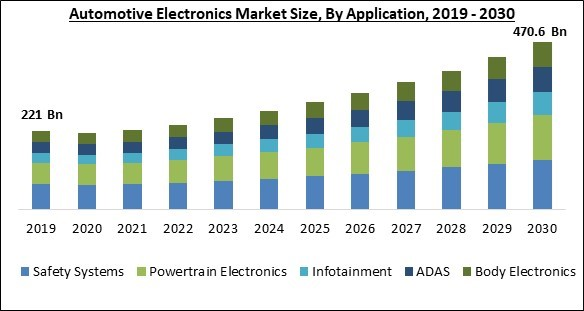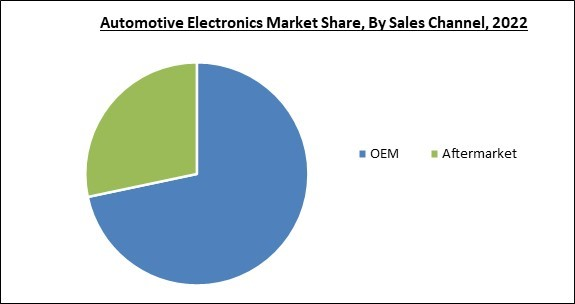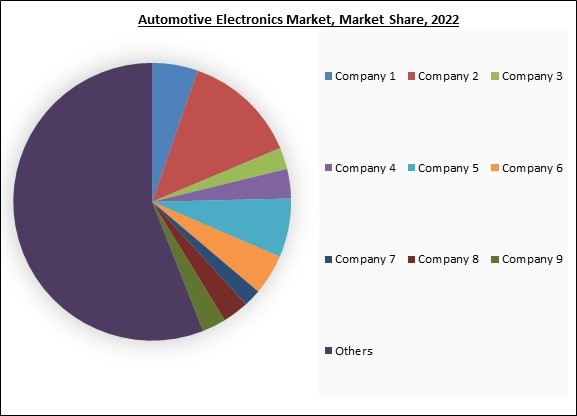The Global Automotive Electronics Market size is expected to reach $470.6 billion by 2030, rising at a market growth of 9.1% CAGR during the forecast period.
Sensors utilized to detect physical factors, the proximity and positioning of a vehicle, chemical qualities, and process variables are included in the sensors segment. Therefore, the sensors segment will capture 1/5thshare of the market by 2030. Governmental initiatives promoting passenger safety and security in a number of countries are anticipated to stimulate revenue expansion. Due to the fact that they monitor variables such as temperature, speed, and tire pressure & condition and take preventative action in the event of peril, these devices have become an integral part of automobiles. Some of the factors impacting the market are increasing demand for electric vehicles, increasing prevalence of vehicles with automated driving, and high cost of development.
The global adoption of electric vehicles (EVs) is increasing rapidly and is expected to continue to rise. According to the International Energy Agency (IEA), over 2.1 million electric vehicles were sold in 2019, accounting for approximately 2.6% of global vehicle sales. Additionally, they accounted for roughly one percent of the worldwide car stock in 2019, a 40% increase year-over-year compared to 2018. Technological advances make the accelerated electrification of lorries, buses, and other vehicles possible, particularly in the battery technology sector. Furthermore, due to its ability to perceive its environment, an autonomous or unmanned vehicle can operate and perform important functions without human intervention. The adoption of autonomous vehicles is augmented by factors like the enhancement of safety, the reduction of traffic congestion, the expansion of connected infrastructure, and the transition from ownership to mobility-as-a-service (MaaS). Thus, the market may experience significant development due to surge in demand for EVs has a significant effect on the market and the growing adoption of sensors and other equipment-equipped automated vehicles.
However, implementing sophisticated electronic technologies and systems in vehicles is expensive, which is one of the primary factors restraining the market. Incorporating advanced electronic systems and technologies into vehicles can substantially increase the vehicle's total cost. This includes the costs associated with components, software development, testing, and integration. Particularly in price-sensitive markets, the higher cost of vehicle electronics may make vehicles more costly for consumers, reducing their accessibility and adoption. This hinders the market's expansion as a whole. These factors are anticipated to hinder the growth of the market.
The leading players in the market are competing with diverse innovative offerings to remain competitive in the market. The above illustration shows the percentage of revenue shared by some of the leading companies in the market. The leading players of the market are adopting various strategies in order to cater demand coming from the different industries. The key developmental strategies in the market are Acquisitions, and Partnerships & Collaborations.
The market research report covers the analysis of key stake holders of the market. Key companies profiled in the report include Continental AG, Robert Bosch GmbH, Sony Corporation, Aptiv PLC, Hyundai Mobis Co., Ltd. (Hyundai Motor), ZF Friedrichshafen AG, Infineon Technologies AG, Magna International, Inc., Aisin Corporation (Toyota Motor Corporation) and Koninklijke Philips N.V.
Sensors utilized to detect physical factors, the proximity and positioning of a vehicle, chemical qualities, and process variables are included in the sensors segment. Therefore, the sensors segment will capture 1/5thshare of the market by 2030. Governmental initiatives promoting passenger safety and security in a number of countries are anticipated to stimulate revenue expansion. Due to the fact that they monitor variables such as temperature, speed, and tire pressure & condition and take preventative action in the event of peril, these devices have become an integral part of automobiles. Some of the factors impacting the market are increasing demand for electric vehicles, increasing prevalence of vehicles with automated driving, and high cost of development.
The global adoption of electric vehicles (EVs) is increasing rapidly and is expected to continue to rise. According to the International Energy Agency (IEA), over 2.1 million electric vehicles were sold in 2019, accounting for approximately 2.6% of global vehicle sales. Additionally, they accounted for roughly one percent of the worldwide car stock in 2019, a 40% increase year-over-year compared to 2018. Technological advances make the accelerated electrification of lorries, buses, and other vehicles possible, particularly in the battery technology sector. Furthermore, due to its ability to perceive its environment, an autonomous or unmanned vehicle can operate and perform important functions without human intervention. The adoption of autonomous vehicles is augmented by factors like the enhancement of safety, the reduction of traffic congestion, the expansion of connected infrastructure, and the transition from ownership to mobility-as-a-service (MaaS). Thus, the market may experience significant development due to surge in demand for EVs has a significant effect on the market and the growing adoption of sensors and other equipment-equipped automated vehicles.
However, implementing sophisticated electronic technologies and systems in vehicles is expensive, which is one of the primary factors restraining the market. Incorporating advanced electronic systems and technologies into vehicles can substantially increase the vehicle's total cost. This includes the costs associated with components, software development, testing, and integration. Particularly in price-sensitive markets, the higher cost of vehicle electronics may make vehicles more costly for consumers, reducing their accessibility and adoption. This hinders the market's expansion as a whole. These factors are anticipated to hinder the growth of the market.
Sales Channel Outlook
Based on the sales channel, the market is segmented into OEM and aftermarket. In 2022, the aftermarket segment covered a considerable revenue share in the market. The term "aftermarket" refers to the secondary market within the automotive industry responsible for the production, distribution, retailing, and installation of all vehicles electrical parts and accessories after the sale of the vehicle to the consumer by the original equipment manufacturer (OEM).Application Outlook
Based on application, the market is segmented into ADAS, infotainment, safety systems, and powertrain electronics. In 2022, the safety systems segment dominated the market with the maximum share. Airbags, keyless entry systems, electronic brake distribution, electric power steering, tire pressure monitoring systems, electronic stability control, and suspension control are examples of safety system components. Rising consumer awareness of technological advancements impacting automobile safety equipment is expected to be a major factor in the market growth.The leading players in the market are competing with diverse innovative offerings to remain competitive in the market. The above illustration shows the percentage of revenue shared by some of the leading companies in the market. The leading players of the market are adopting various strategies in order to cater demand coming from the different industries. The key developmental strategies in the market are Acquisitions, and Partnerships & Collaborations.
Component Outlook
Based on components, the market is segmented into electronic control units, sensors, current-carrying devices, among others. The current-carrying devices segment held the highest revenue share in the market. This results from the high cost of components, such as connectors and wiring harnesses. Additionally, government programs like Make in India and factors like lower labor costs and higher disposable income in developing economies have increased the manufacturing of passenger automobiles and light commercial vehicles.Regional Outlook
Region wise, the market is analyzed across North America, Europe, Asia-Pacific, and LAMEA. In 2022, the Asia Pacific region witnessed the largest revenue share in the market. South Korea, Taiwan, Malaysia, and Thailand have considerably contributed to the market's growth due to their thriving electronic component manufacturing industries. China and Japan satisfy the vast majority of automotive electronics demand in Asia-Pacific. Yet, the limited number of automotive electronics OEMs creates an ideal investment prospect for regional suppliers to take advantage of local demand, making the rest of the Asia-Pacific region attractive to capitalists.The market research report covers the analysis of key stake holders of the market. Key companies profiled in the report include Continental AG, Robert Bosch GmbH, Sony Corporation, Aptiv PLC, Hyundai Mobis Co., Ltd. (Hyundai Motor), ZF Friedrichshafen AG, Infineon Technologies AG, Magna International, Inc., Aisin Corporation (Toyota Motor Corporation) and Koninklijke Philips N.V.
Strategies Deployed in the Market
- Apr-2023: Continental AG and HERE Technologies came into partnership with IVECO, for powering all of Iveco's commercial vehicles with fuel-saving functions and intelligent Speed Assistance. These will be powered using Continental's eHorizon platform, which aggregates and distributes HERE map content. Continental's scalable 4G/5G telematics control unit will facilitate data sharing.
- Jan-2023: Continental came into partnership with Ambarella, an edge AI semiconductor company. Together, the companies aim to create scalable, all-encompassing hardware and software solutions based on artificial intelligence (AI) for aided and automated driving (AD) as a step toward autonomous mobility. By incorporating Ambarella's energy-efficient System-on-Chip (SoC) family into its Advanced Driver Assistance Systems (ADAS), the companies will work together strategically.
- Jan-2023: Hyundai Mobis, a division of Hyundai Motor announced a partnership with Qualcomm for creating an autonomous driving system. Hyundai Mobis will work on creating an integrated autonomous driving controller that can scale up to level 3 based on Qualcomm's Snapdragon Ride Platforms. The controller would allow Hyundai Mobis to develop a software platform that can achieve level 3 or higher autonomous driving in less than six months.
- Sep-2022: Continental Automotive Singapore Pte Ltd., a division of Continental AG came into an agreement with Go-Ahead and Nanyang Technological University. The agreement aimed to create and enhance the driving safety systems of Go-Ahead's buses. Additionally, the agreement focuses on identifying the underlying causes of risks by enhancing descriptive analytics' prediction capabilities, taking them to the next level, and developing diagnoses.
- Apr-2022: Bosch announced the acquisition of Five AI Ltd., a company focused on cloud-based development and testing platforms for self-driving software. The acquisition enabled Bosch to advance its software development for safe automated driving and offer European-made products to its clients.
- Mar-2022: Bosch took over Atlatec, a company focused on creating high-resolution 3D maps. By enhancing Bosch's capabilities in the area of high-resolution digital maps, the companies aimed to broaden their offering for autonomous driving. With this acquisition, Bosch became the lone provider of all the technology needed for automated driving, from software and maps to actuators and sensors.
- Oct-2021: Bosch came into collaboration with Carnegie Mellon University, a research university. Following this collaboration, the companies concentrated on creating a framework for XR applications that could show how the real and virtual worlds interact. The Industrial Internet of Things (IIoT) environment served as the foundation for this planned XR's architecture, which was built with dependability, real-time performance, and safety in mind.
- Feb-2021: Bosh teamed up with Microsoft for developing a new automotive software platform. The companies aimed to make the process of installing automobile over-the-air updates as quick and painless as updating the iPhone's operating system. This new platform not only provides a smooth experience but also speeds up drivers' access to new features and digital services as they become available during the lifetime of their cars.
- May-2020: Continental partnered with Pioneer Corporation, a company specializing in digital entertainment systems. Under this partnership, Continental integrates Pioneer's whole infotainment area into its high-performance cockpit computer. With a particular focus on the Asian market, this partnership aimed to create an integrated infotainment system.
Scope of the Study
Market Segments Covered in the Report:
By Application
- Safety Systems
- Powertrain Electronics
- Infotainment
- ADAS
- Body Electronics
By Sales Channel
- OEM
- Aftermarket
By Component
- Current Carrying Devices
- Sensors
- Electronic Control Unit
- Others
By Geography
- North America
- US
- Canada
- Mexico
- Rest of North America
- Europe
- Germany
- UK
- France
- Russia
- Spain
- Italy
- Rest of Europe
- Asia Pacific
- China
- Japan
- India
- South Korea
- Singapore
- Malaysia
- Rest of Asia Pacific
- LAMEA
- Brazil
- Argentina
- UAE
- Saudi Arabia
- South Africa
- Nigeria
- Rest of LAMEA
Key Market Players
List of Companies Profiled in the Report:
- Continental AG
- Robert Bosch GmbH
- Sony Corporation
- Aptiv PLC
- Hyundai Mobis Co., Ltd. (Hyundai Motor)
- ZF Friedrichshafen AG
- Infineon Technologies AG
- Magna International, Inc.
- Aisin Corporation (Toyota Motor Corporation)
- Koninklijke Philips N.V.
Unique Offerings
- Exhaustive coverage
- The highest number of Market tables and figures
- Subscription-based model available
- Guaranteed best price
- Assured post sales research support with 10% customization free
Table of Contents
Chapter 1. Market Scope & Methodology
Chapter 2. Market at a Glance
Chapter 3. Market Overview
Chapter 4. Competition Analysis - Global
Chapter 5. Global Automotive Electronics Market by Application
Chapter 6. Global Automotive Electronics Market by Sales Channel
Chapter 7. Global Automotive Electronics Market by Component
Chapter 8. Global Automotive Electronics Market by Region
Chapter 9. Company Profiles
Companies Mentioned
- Continental AG
- Robert Bosch GmbH
- Sony Corporation
- Aptiv PLC
- Hyundai Mobis Co., Ltd. (Hyundai Motor)
- ZF Friedrichshafen AG
- Infineon Technologies AG
- Magna International, Inc.
- Aisin Corporation (Toyota Motor Corporation)
- Koninklijke Philips N.V.
Methodology

LOADING...











